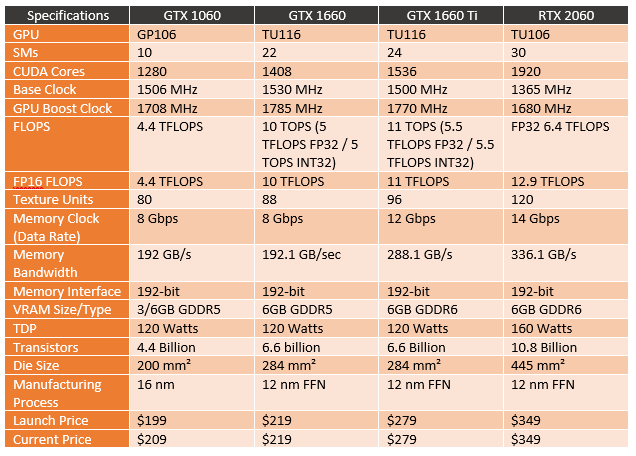Nvidia introduced the GTX 1660 Ti late in February and this answered a lot of questions about how the rest of the product stack would fill in under all of their recently launched Turing based RTX cards. The GTX 1660 Ti showed that they were bringing Turing to the mainstream cards by dropping ray tracing and it quickly jumped past the GTX 1070 and put AMD into a pricing bind with the Vega 56 as well as the RX590. Well, the GTX 1660 Ti name did bring up a lot of questions as to why they didn’t stick with the 2000 series or even move up to the 1100 series from the previous GTX cards. But the Ti in the name did let us know that there would most likely be a model that slotted in below it and today that card, the GTX 1660 launches. There aren’t Founders Edition models so we had to reach out to get a card and Zotac was kind enough to send their GTX 1660 so I am going to take a look at that today and see how Nvidia’s new card compares to the GTX 1060, GTX 1660 Ti, and of course the RX580 and RX590 from AMD.
Product Name: Zotac GTX 1660
Review Sample Provided by: Zotac
Written by: Wes Compton
Pictures by: Wes Compton
Amazon Affiliate Link: HERE
GTX 1660, no Ti?
Before we get into the normal card review. I did want to take a look at what the GTX 1660 is. The dropped the Ti but what else changed? Well, a quick look at our specifications below fills in a lot of blanks. For starters, the GTX 1660 is based on the same TU116 GPU as the GTX 1660 Ti. So you are still getting the hybrid Turing architecture without the RT cores. You still get the shader innovations that play a big part in Turing's performance as well as the unified cache and adaptive shading. I talk a lot more about those in the GTX 1660 Ti launch article and in the RTX 2080 Ti launch article. I’m not going to go into depth again today, but just know that the GTX 1660 does have the same GPU base as the GTX 1660 Ti. What they did change, however, is the number of SMs. They dropped from 24 down to 22 which isn’t a big jump but by turning off two SMs they drop the number of CUDA cores down from 1536 to 1408. They did turn the clock speeds up slightly, the base clock is now 1530 MHz and the boost clock is 1785 MHz which is up from 1770 MHz.
The dropped SM count ends up translating to 10 TOPS compared to 11 TOPs on the GTX 1660 Ti or 5 TFLOPS for FP32 and 5 TOPS in INT32 performance which as we learned with Turing can run independently of each other now. Most of the memory specifications didn’t change, we still have a 192-bit memory interface and the GTX 1660 at least right now comes with 6GB of VRAM. They did, however, switch from the GDDR6 on the GTX 1660 Ti which was also used on all of the RTX cards back down to older GDDR5. This is running at 8 Gbps vs 12 Gbps on the Ti. This results in memory bandwidth going from 288.1 GB/s on the GTX 1660 Ti down to 192.1 GB/s on the GTX 1660. Basically, the GTX 1660 has the memory of the GTX 1060 but the GPU of the GTX 1660 Ti.
The transistor count didn’t change from the GTX 1660 Ti to the GTX 1660, they are using the same GPU as I mentioned. The die size is the same as well. This is still 2.2 billion more transistors than the GTX 1060 and the die size reflects that as well. Even with it being built on a 12 nm FFN process compared to the 12 nm process on the older GTX 1060. The TDP stays the same as well, sitting at 120 watts which both the GTX 1060 and the GTX 1660 Ti also run at. As for pricing, this new card is launching at $219 which is $60 less than the GTX 1660 Ti. I was most curious how this compared to the GTX 1060, that was a sticking point for me with the Ti launch because it was so much higher than the GTX 1060 was at launch. $219 is still higher than the $199 launch price, but closer to a cost of living increase as would be expected. Now we don’t know how this new card performs, but that $219 price point is a lot more exciting than the GTX 1660 Ti, so it will be interesting to see how it performs later.

Before I get into testing, I do want to include a copy of our GPUz from the Zotac card we will be testing. This was everyone can see what BIOS version I tested on and the driver I used (which was the 419.35 driver Nvidia provided pre-launch). The clock speeds of this card match the 1530 MHz base clock and 1785 MHz boost clock that the GTX 1660 has listed as stock so this isn’t an overclocked card, giving us a great look at stock performance.
Packaging
The box for the Zotac card may look in proportion but it was a small box. It still has the normal Nvidia wrap around that includes the GTX branding and the model name, but because of the boxes size, this takes up a little more space than on most boxes. Zotac still got their branding up in the top left corner and unlike nearly every other company Zotac didn’t need to include any sub-brand or model name. The 6GB VRAM capacity is there as is a tag showing their FireStorm software and that they have an extended warranty, that’s about it for the front. I would love to see a picture of the card on the front rather than the grey on grey on grey design in the background, but that is about it. There is a picture of the card around back where they highlight that this a compact card, is VR Ready, and their Firestorm software again. Beyond that, there is a feature and specification listing. That listing really only shows the basics. They do show that an 8-pin power connection is needed and a list of the display connections which are both important but I would love to see memory and clock speeds as well as card dimensions as well.


Inside of the box, there is a formed cardboard tray that has the card in it. The card also comes in a static protective bubble wrap bag as well for a little extra protection. Then on top, they have a small pouch with the Zotac Gaming logo on it. Inside of that, you get some documentation. That includes a quick installation guide and a paper that explains where you can get the most up to date drivers. They also show off their MEK gaming PCs which I don’t think anyone buying a video card needs. You also get a Zotac Gaming case sticker.


Card Layout and Photos
The box for the Zotac GTX 1660 was smaller than normal, but that is because the card itself is small at as well. I thought this was a proper ITX sized card, but Zotac did oversize the card just slightly. The PCB comes out to 6 7/8 inches which is 175mm but with the fan shroud sticking out at the end the card is 7 inches or 177.8mm. ITX is close at 170mm so this will most likely still work, but in the most compact situations, you want to keep in mind that slight difference. That extra space did help them fit a dual fan design into the form factor but if you look close they are actually two different sizes as well. The left fan is a 65mm fan and the right is 75mm. The all black fan shroud wraps around both with a design that is similar to the Zotac Gaming logo.



Really though, I didn’t even notice the two fan sizes until later in my testing and that all black design helps hide the difference. Looking down through the two fans we can see that Zotac did go with a sheet metal heatsink design which runs horizontally. Combined with the axial fan design the airflow blows down into the heatsink and at least part of the air will be pushed to the PCI bracket and out the end of the card. The larger fan does reach out past the heatsink on the top edge, blowing some out the top after going across the heatpipes. Not visible in this image, but I also should note that the fan shroud design does integrate down around the fans as well to help with that airflow, most cards just end at the thickness of the shroud and let air go anywhere. A proper shroud design is nice to see.

Looking around the top, bottom, and end of the card shows us a little more about the cooler design that Zotac went with. For starters, up on the top edge, we can see that they use three heatpipes. The bottom view shows that they run right up on top of the GPU and pull heat out across the heatsink and the heatpipes are lined up at the ends of the heatsink with the third in the middle between the fans best take advantage of the fan's airflow. The heatsink also touches on top of the VRM which on the PCI bracket end of the card as well as the memory which you can see on the bottom edge view. The end of the card view shows that Zotac built their heatsink around each component like the power connection, not using a universal design like some cards use.



The all black fan shroud also avoids any lighting so on the top edge Zotac kept things simple with their Zotac Gaming brand in the middle and the Geforce GTX branding next to it. I would prefer to see GTX 1660, but by just using the basic branding they can share this cooler across a few card models like their GTX 1660 Ti. This also gives us a good look at the 8-pin connection, given the same TDP and same base GPU as the GTX 1660 Ti this isn’t a big shocker.

As for the back of the Zotac GTX 1660 they didn’t do anything crazy back here. You can see the notch at the power connection and we can see that the overall card height is stock. Beyond that, the six screws that hold the cooler on are easy to get at. There isn’t a backplate or any protection. But you do at least get a black PCB that should hopefully blend in.

The cooler design is designed to push some of its air out the PCI bracket and while there is a gap on the shroud before this so you can’t expect it all to go out this way like a proper blower card. But Zotac did leave a lot of room for venation here with all of the display connection tucked up against the PCB. You get three DisplayPort connections and one HDMI and I know I have been ranting about it but at these lower price points I think DVI is still needed for some people but there are a few adapter options from both DisplayPort and HDMI at least.

To put the overall card size into perspective I did grab the GTX 1660 Ti Ventus XS that I recently reviewed from MSI. You can see how much smaller the Zotac design looks when they are at least close to the ITX form factor length and sticking with a standard PCI card height.

Test Rig and Procedures
Our Test Rig Configuration (with affiliate links)
CPU - Intel i9-7960X
Motherboard - Asus ROG Rampage VI Apex
Memory - HyperX DDR4 Predator 3000MHz
Storage - Kingston A1000 960GB M.2 SSD
Cooling - Noctua NH-U12S
Power Supply - Corsair AX1200w
Case - Primochill Wetbench

Synthetic Benchmarks
To start off my testing I ran the Zotac GTX 1660 through a few synthetic benchmarks so we could get a solid comparison between it and a few other cards like the GTX 1060, GTX 1660 Ti, and the RX 590 and RX 590 duo that are all around the price range of the GTX 1660 or the next closest up or down. I first started in the DX11 based Fire Strike tests. I’ve found that all of the Turing based GPUs favor DX12 tests over DX11 and you can see it in these results. In the Performance setting and extreme setting the GTX 1660 came in ahead of the GTX 1060 but a decent amount but behind other cards like the RX580. With the detail, all the way up in the ultra test the GTX 1060 pulled ahead there as well. That is a 4k focused test which isn’t really the target for the GTX 1660 but still very interesting that the GTX 1060 is a better choice in that situation.


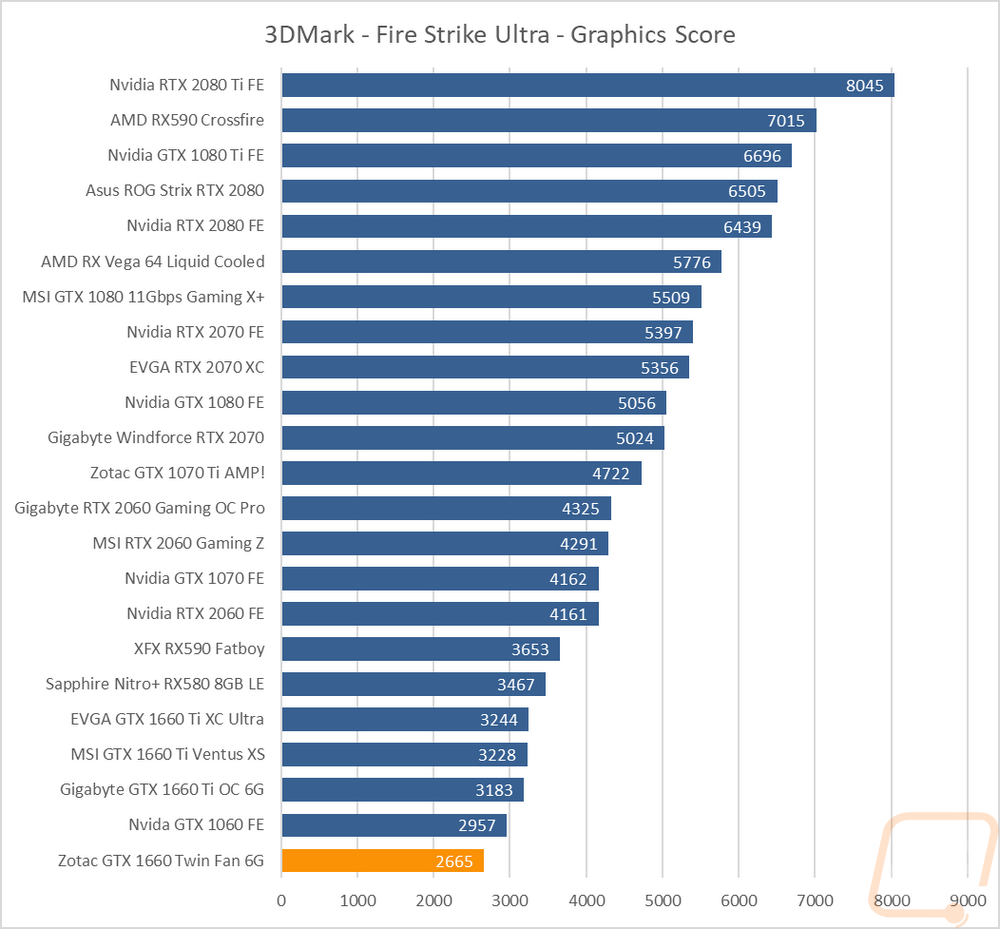
Now in the DX12 based Time Spy benchmarks things looked a little different. Here the GTX 1660 was significantly ahead of the GTX 1060 and even inching closer to the performance of the GTX 1070 with the RX580 and RX590 both behind it in performance.


I also did some testing in Unigine Superposition where I tested twice at 1080p with medium and then extreme detail levels and then again at 4k and 8k for a look at the ultra-high resolutions. Performance in all four of the tests were similar to what we saw previously. This is a DX11 based test but the GTX 1660 did outperform the RX 580 and RX 590 as well as the GTX 1060 with the next fastest card being the three GTX 1660 Tis.

VR Benchmarks
I love VR games but knowing if your system is going to handle VR well is a little more hit and miss. Sure you have VR ready logos on video cards and just about anything else they can be put on. But there aren’t very many benchmarks available for card to card comparison for anyone without a headset. So I have two tests that do allow for a look at performance before buying here with SteamVR and then VRMark. SteamVR has been a little stagnant with all of the RTX cards reaching 11 which is the highest score it allows so comparing between them isn’t possible. But the GTX 1660 Ti and now the GTX 1660 fall a little under that and we can finally better use this test. The GTX 1660 comes in with a 9.1 which has a big gap in performance between the GTX 1660 Ti. But you can see it is faster than the GTX 1060, RX 590, and RX580 which are all in the 8 or lower range.
 The second benchmark is VRMark and it actually has a few different tests which allow a look at a few different VR situations. Orange room is similar to SteamVR in that it is focused on current day basic VR games. Cyan is also current day but with high detailed VR games and then blue room looks at potential future performance when VR games reach close to today's highest detailed games. In all three 109, FPS is the goal, anything lower wouldn’t be smooth and as you can see all of the games did this in the orange room. Cyan, on the other hand, the GTX 1060 struggles a lot and the RX580 is on the edge but as you can see the GTX 1660 is up past that, not by a large margin and the R590 does do a little better. Then in blue room, the GTX 1660 is ahead again, but still far far away from the 109 FPS needed for that test.
The second benchmark is VRMark and it actually has a few different tests which allow a look at a few different VR situations. Orange room is similar to SteamVR in that it is focused on current day basic VR games. Cyan is also current day but with high detailed VR games and then blue room looks at potential future performance when VR games reach close to today's highest detailed games. In all three 109, FPS is the goal, anything lower wouldn’t be smooth and as you can see all of the games did this in the orange room. Cyan, on the other hand, the GTX 1060 struggles a lot and the RX580 is on the edge but as you can see the GTX 1660 is up past that, not by a large margin and the R590 does do a little better. Then in blue room, the GTX 1660 is ahead again, but still far far away from the 109 FPS needed for that test.

In-Game Benchmarks
Now we finally get into the in game performance and that is the main reason people pick up a new video card. To test things out I ran through our new benchmark suite that tests 12 games at three different resolutions (1080p, 1440p, and 4k). I also slipped in a few variations on the same games for comparisons like DX11 to DX12, OpenGL to Vulkan, and a couple of games are just tested at their highest setting and lower but still high detail options to show the performance difference when things are turned down slightly. In total, each video card is tested 54 times and that makes for a huge mess of graphs when you put them all together. To help with that I like to start off with these overall playability graphs that take all of the results and give an easier to read the result. I have one for each of the three resolutions and each is broken up into four FPS ranges. Under 30 FPS is considered unplayable, over 30 is playable but not ideal, over 60 is the sweet spot, and then over 120 FPS is for high refresh rate monitors. This covers all of the games tested except Final Fantasy XV that we have a score rather than an FPS because they like to be different.
So how did the Zotac GTX 1660 Twin Fan 6G perform? At 1080p there wasn’t a significant difference in the playability graphs compared to the GTX 1660 Ti. You have three our the games tested running at over 120 FPS and 11 over 60 FPS. Just 3 were in that 30-60 range that is playable but needs some adjustment. 1440p however where the GTX 1660 Ti had a few over 120 the GTX 1660 had none and 9 over 60 FPS dropped down to 7 with the 30-60 range going from 6 to 10. So 1440p is still playable but a majority of the games weren’t silky smooth. Then at 4k the GTX 1660 really fell on its face with 10 tests unplayable and only 1 over 60 FPS.



Of course, the actual game performance numbers are the most important if you are crazy enough to sort through them all with me. So as expected given the specifications, the GTX 1660 Ti still has a leg up in performance. From there the GTX 1070 was ahead of the GTX 1660 and then in most tests, the GTX 1660 was ahead of the RX 580 and RX 590. There are a few games where the RX590 does outperform like Hitman in DX12 and it does a little better at 4k but only slightly and this is related to its 8GB of VRAM and 256-bit memory interface being able to handle the higher resolution a little better. But 4k for the RX590 or the GTX 1660 isn’t all that realistic so it matters very little which is the faster when both struggle at that resolution. One thing is clear though, the GTX 1660 is still significantly faster than the GTX 1060 and the RX 580 as well. At 1440p the RX 590 and the GTX 1660 are close in performance but at 1080p which is where I would recommend using this card, the GTX 1660 is faster.
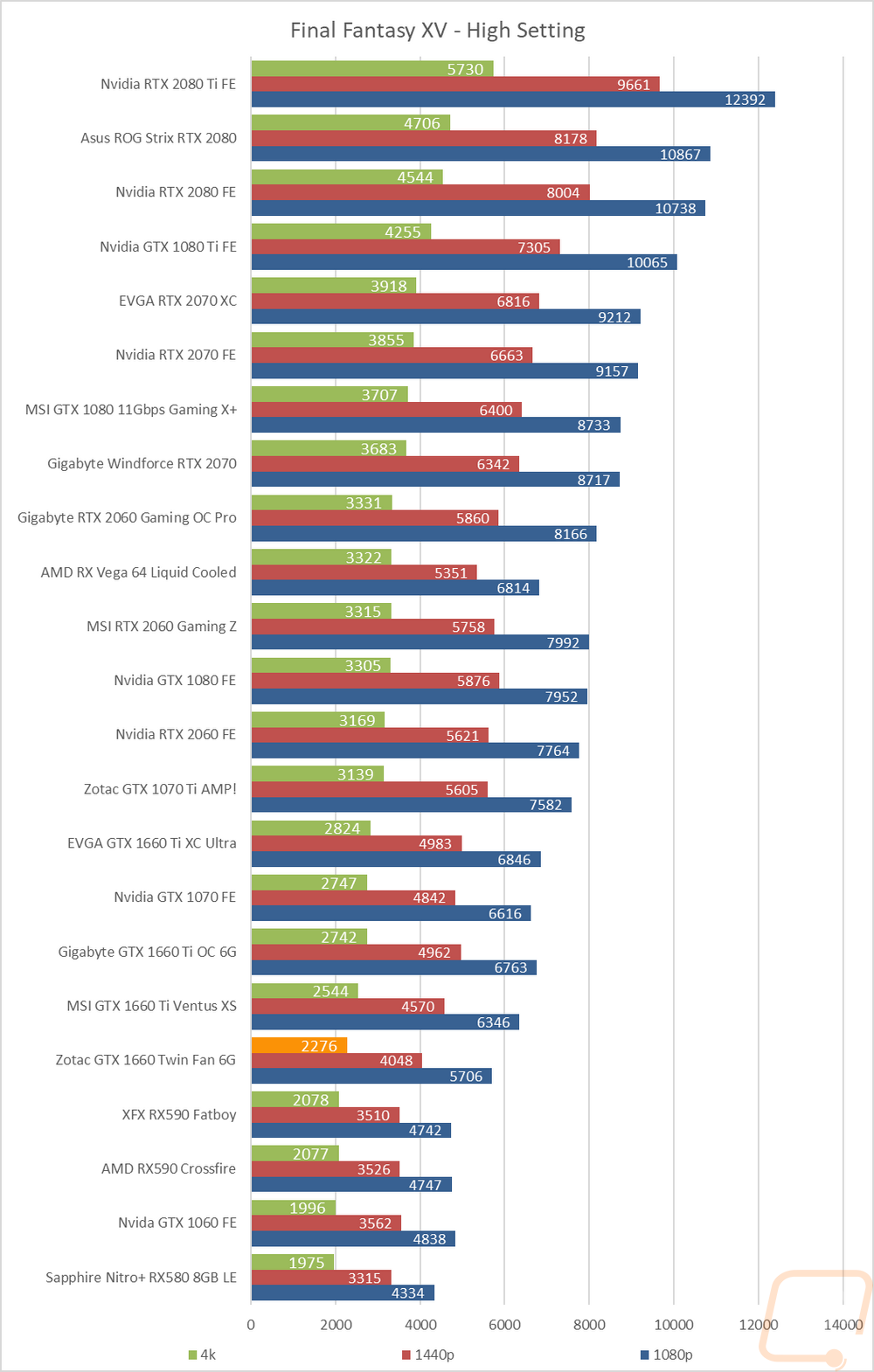



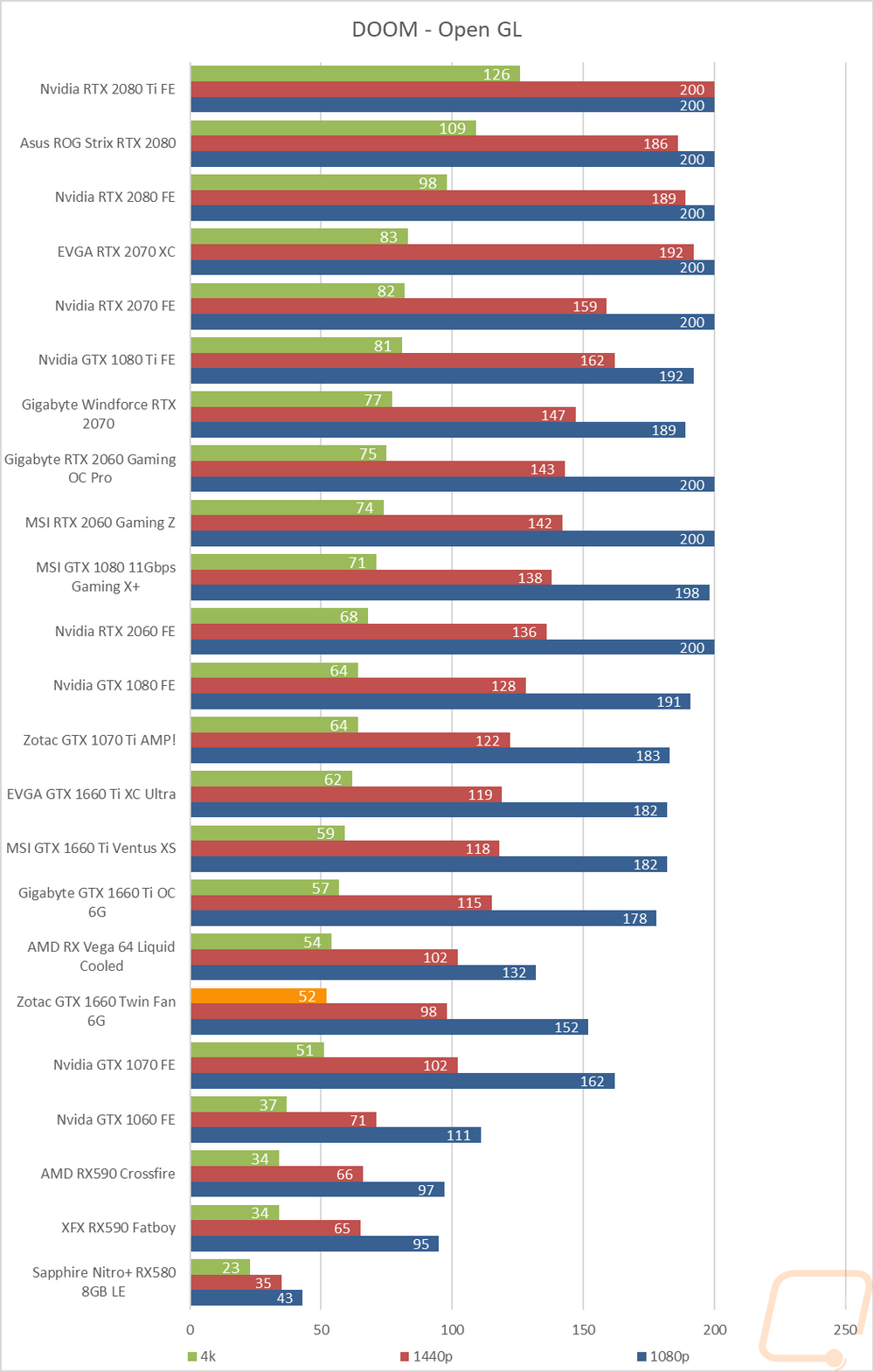













Compute Benchmarks
Now some people like to game and then use the same PC for work or a better example would be gamers who want to record or stream. There are situations where gaming isn’t the only thing you might use your new GPU for and to take a look at compute performance I run a few tests. The first one is using Passmark’s Performance Test 9 where I run the GPU Compute test. It is a general synthetic test but it does give us an overall look. I was surprised to see the GTX 1060 up ahead in this one with the GTX 1660 sitting between the RX 580 and RX 590.
 Next and I think my favorite test is Blender which is an open source 3D modeling software that is extremely popular. For this test, I use the base benchmark but I have it updated with a mid-January build to add in support for the RTX cards which isn’t available with the base benchmark. It is a timed benchmark rendering two different situations and the GTX 1660 did well here. It slipped past the GTX 1660 Ti from MSI which clearly had problems and is significantly faster than even the GTX 1070 Ti let alone the cards closer to this in a price range like the GTX 1060 which takes almost twice as long.
Next and I think my favorite test is Blender which is an open source 3D modeling software that is extremely popular. For this test, I use the base benchmark but I have it updated with a mid-January build to add in support for the RTX cards which isn’t available with the base benchmark. It is a timed benchmark rendering two different situations and the GTX 1660 did well here. It slipped past the GTX 1660 Ti from MSI which clearly had problems and is significantly faster than even the GTX 1070 Ti let alone the cards closer to this in a price range like the GTX 1060 which takes almost twice as long.

The next test was Basemark GPU where I ran their test in both DX12 and OpenGL and you can really see the performance gap here between the GTX 1660 and the GTX 1060.

Geekbench 4 is similar with their GPU Compute benchmark running OpenCL and the GTX 1660 finds a happy medium between the GTX 1660 Ti and the GTX 1060 with it a little closer on the GTX 1660 Ti side than the GTX 1060.
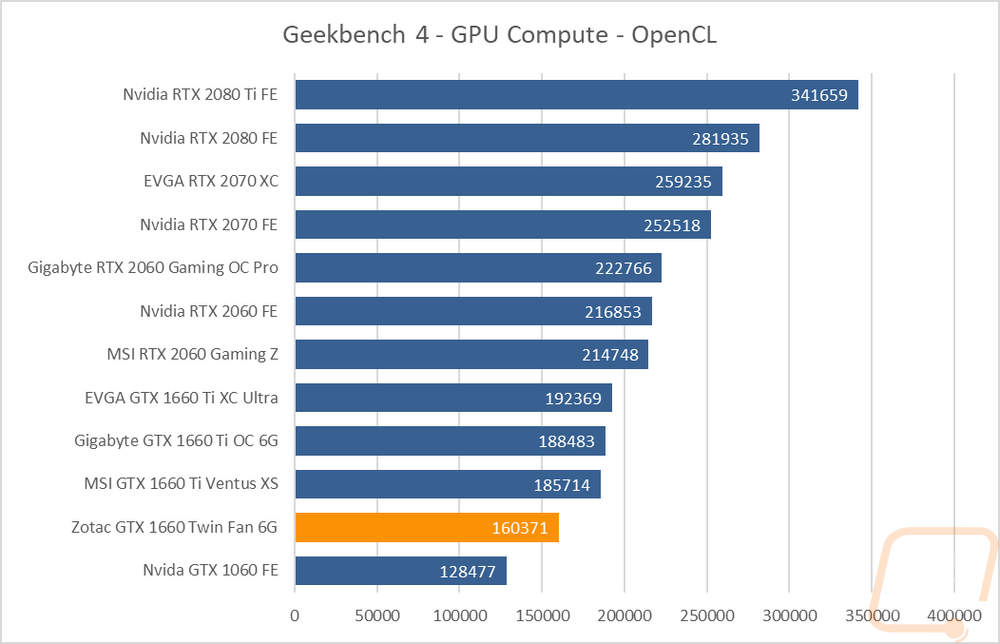
Cooling Noise, and Power
There are a few other aspects that are important when picking out a video card, especially once you know which GPU you want. Cooling, power, and noise are all different from model to model, even with the same GPU and from the same company. They depend on the overclock when cards are overclocked, our Zotac GTX 1660 isn’t overclocked though. Then the cooler and fan designs change the temps and noise levels.
My first tests on the Zotac GTX 1660 were taking a look at power usage. I tested twice, once using 3DMark Fire Strike’s Combined benchmark to load the GPU and CPU similarly to a game and then a second time with AIDA64 Stress Test on the GPU for a GPU only load. Both were monitored with a Kill-A-Watt hooked up to the testbench to give us total system draw in wattage. In 3DMark the system with the GTX 1660 pulled 276 watts which is 19 watts less than the GTX 1660 Ti but still 22 watts up over the original GTX 1060. With just the GPU loaded in AIDA64, the system pulled a total of 217 watts which was basically on par with the other GTX 1660 Tis. Given the matching TDPs and how hard AIDA64 stresses the GPU this wasn’t a huge surprise.
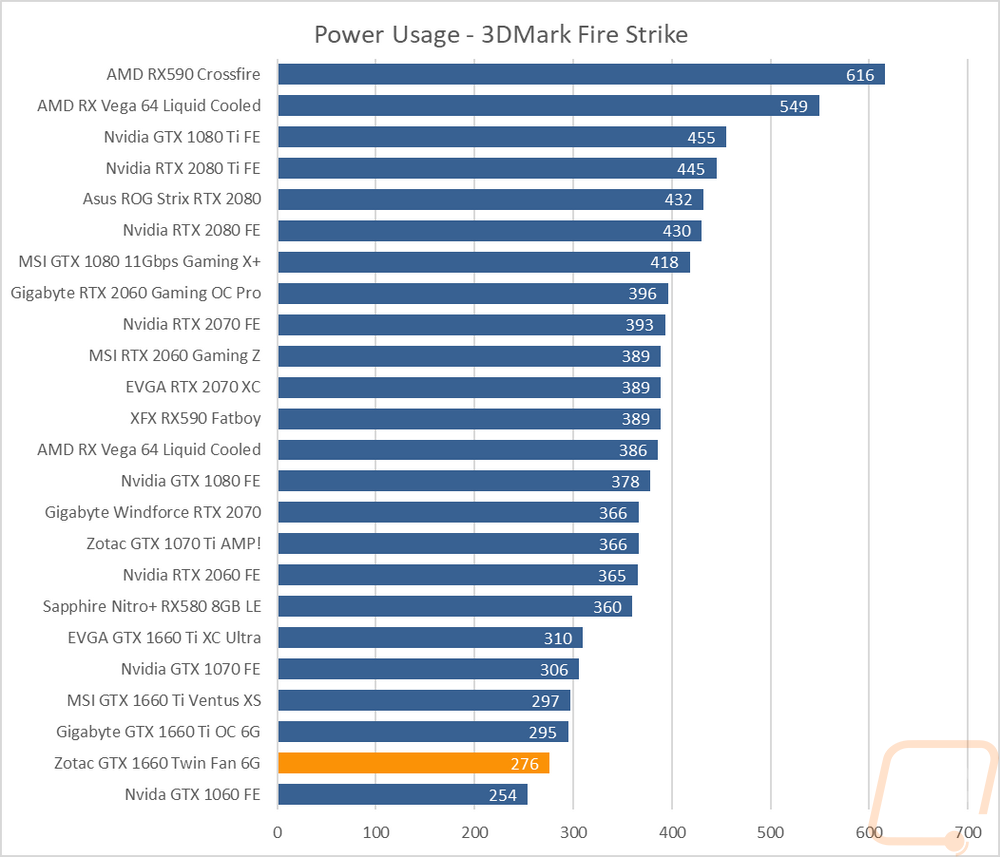

Next, I wanted to take a look at fan noise levels. To do this I used our decibel meter setup 18 inches away from the GPU on our open-air testbench. An inside the case test would be a little quieter, but I’m only aiming to get actual fan noise levels. Different cases will have different noise levels and I would prefer to keep those variables out of these results. What I found was that with the two fans turned up to 100% the Zotac card was in the middle of the pack for noise which isn’t too bad considering the fans actually run up closer to the top in fan speeds. 50% fan speeds were a little better with it closer to quieter fans. I also tested the fan noise when under the long term temperature testing as well but being a new test I don’t have a graph with comparison numbers just yet so, for now, it is a happy treat for people reading this. Max temp fan speeds were quieter than both the 50 and 100 percent tests at 35.5. For comparison, the Gigabyte GTX 1660 Ti that I tested earlier this week ran at 37.1 decibels in the same test.
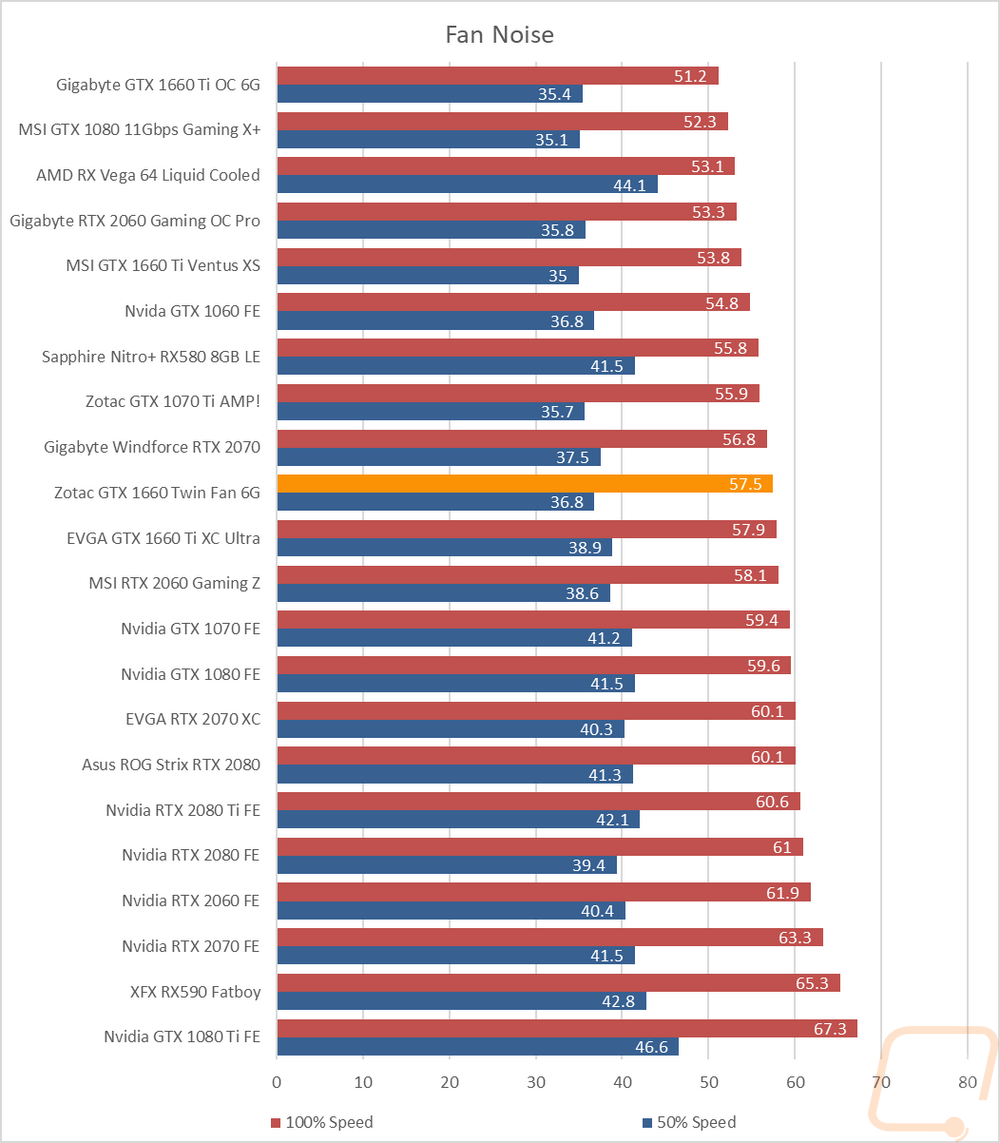
 My last tests were focused on temperatures. Here I ran AIDA64 again for a full load and let it run for a half hour and confirmed that the temperatures had leveled off. With the heatsink fully heat soaked and the stock fan profile the Zotac GTX 1660 ran at a solid 56 degrees which was cooler than all of the different GTX 1660 Ti’s that I have tested. To get an idea of how much room Zotac's cooler has left in it I then did the same test with the fans at 100% fan speed to see what temperature it would run. 44 degrees was good, and the delta between the stock profile (56 degrees) and the 100% fan speed (44 degrees) wasn’t bad but you can see that a few cards like the EVGA 1660 Ti Ultra which have better coolers pulled ahead here when fan noise wasn’t a concern.
My last tests were focused on temperatures. Here I ran AIDA64 again for a full load and let it run for a half hour and confirmed that the temperatures had leveled off. With the heatsink fully heat soaked and the stock fan profile the Zotac GTX 1660 ran at a solid 56 degrees which was cooler than all of the different GTX 1660 Ti’s that I have tested. To get an idea of how much room Zotac's cooler has left in it I then did the same test with the fans at 100% fan speed to see what temperature it would run. 44 degrees was good, and the delta between the stock profile (56 degrees) and the 100% fan speed (44 degrees) wasn’t bad but you can see that a few cards like the EVGA 1660 Ti Ultra which have better coolers pulled ahead here when fan noise wasn’t a concern.
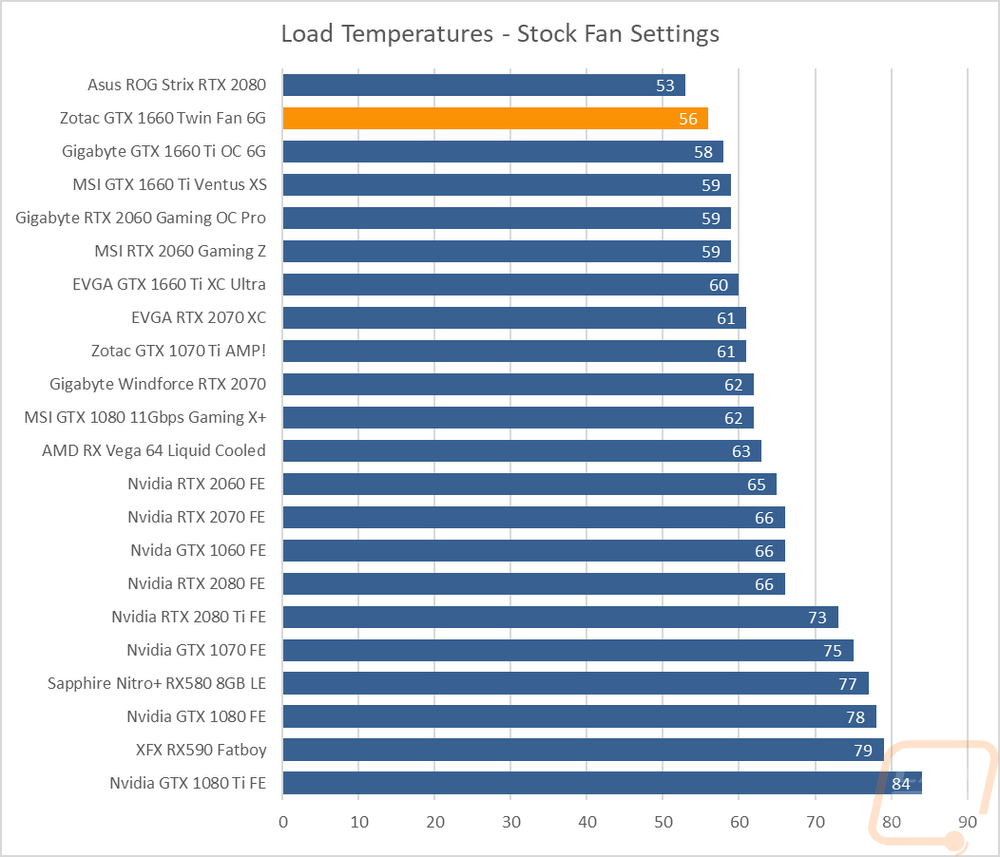

When doing the stock fan profile temperature testing I also took a few minutes to get thermal images of the card. I was curious how the two different fan sizes might show here and I wanted to see if there were any hot spots showing on the back of the PCB. The fans did show a significant difference in performance on the smaller left fan on the right side near that heatpipe. That is also the same area where the VRM is running, combining those two heat loads under the one fan overloads that smaller fan slightly. You can see the same thing when looking at the back of the PCB where there is a hot spot which runs hotter than the back of the GPU area.


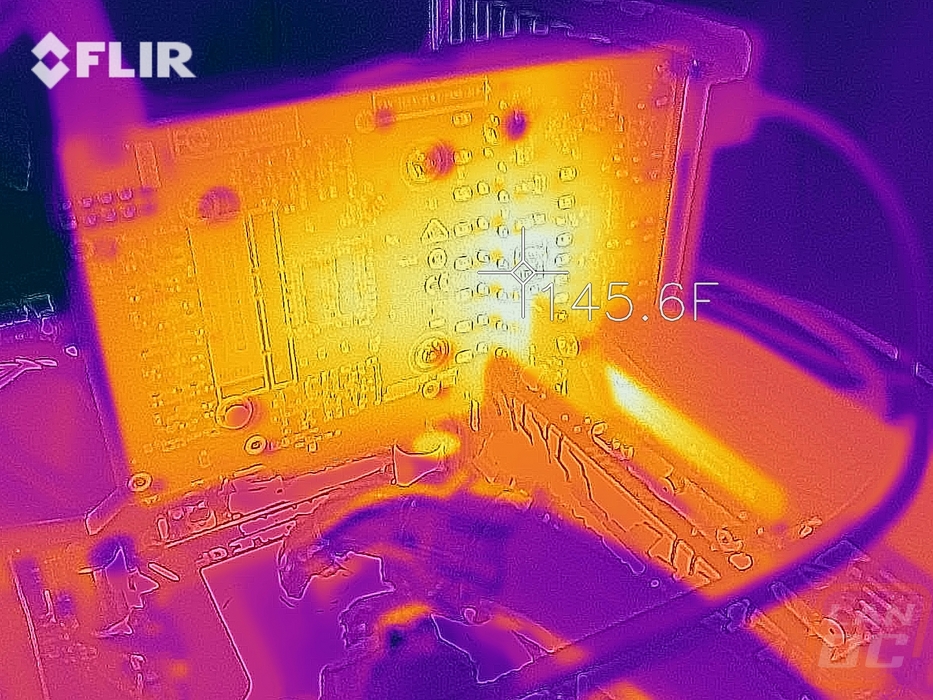
Overall and Final Verdict
So, of course, the Vega 64’s, Titans, and RTX 2080 Ti’s are exciting and I love seeing them come in. But the real workhorses so to speak are cards like the GTX 1660 Ti and now the GTX 1660. Steam hardware survey still has 1080p being run by 62% of the PCs tested with the next highest use being 1366 x 768 which is on 13% of setups. So while you might think that everyone is running 4k or 1440p that isn’t really the reality, those are only a portion of the market. Gamers looking to increase performance at 1080p is where it is at and the GTX 1660 is doing that with flying colors, even at the extremely high settings that I do most of my testing at. Nvidia has taken the TU116 GPU used in the GTX 1660 Ti and pulled two SMs to tune things down slightly but it still handles 1080p perfectly and has some room at 1440p as well. I was especially impressed with its performance in Blender, those of you looking to burn the candle at both ends with gaming and 3D work will be happy.
The Zotac card, well I was really digging the small design. Especially the all blacked out design including the black PCB. I didn’t catch that one of the fans was smaller than the other until I was doing measurements while writing, but that weird combination of fan sizes allowed them to keep a stock height card. My only disappointment was that it didn’t end up fitting in the true ITX form factor for cards which is 170mm. It was extremely close, but Zotac seems to play fast and loose with that ITX size sometimes. It should still fit in a lot of those SFF cases that only support ITX sized cards, especially with the standard height which no one seems to do anymore. I would have been happier if the card still had a DVI port, remember all of those gamers who aren’t running new monitors some of those will need that port. I was also a little sad to see the backplate go.
Cooling performance was good but the small Zotac card did drop off when compared to cards like the EVGA Ultra which had a huge heatsink. Noise testing was in the mid-range as well. So Zotac ended up not being spectacularly bad or good in those areas, which is all you really need.
Really with all of that in mind, it all comes down to the pricing and Nvidia did drop the GTX 1660 down into a price range that I really like. The MSRP is $219 and given that this Zotac card has that same price I am hoping we see lots of cards available at that price. Assuming no funny business with inventory $219 is a great price for anyone building a mid range PC. You can build a 6 core Ryzen system with 16 gigs of memory, a 500+ GB NVMe SSD, and even a modular power supply from a brand you know for less than $650 with this video card. Last year that same setup would have been twice as much and with a much slower video card. Not only are prices finally coming back to normal, but Nvidia has a new GPU to go with them. Budget is back! At $219 the GTX 1660 has the RX590 which was slower selling for $239.99 (checking this last minute there is now one for $219.99). AMD does have a good game bundle helping with that, but I would still go with the GTX 1660 right now. The RX 580 is a much better deal with them running in the $170-180 range but again the performance was night and day. Then you have the GTX 1060 which was looking especially dated in our testing, most of the 6GB models are selling at or above the GTX 1660’s price as well. Baring any significant price changes the GTX 1660 is looking like a great option right now.


Live Pricing: HERE


